Structured interviews and unstructured interviews are two styles of conversations with potential employees that help you choose the best person for a given role. Each style has pros and cons, but which works better for finding the right person more quickly?
As a business owner or hiring manager, you want to use the interview method that helps you find talented people in the most efficient way possible. Fortunately, you don't have to choose just one style — you can blend the strengths of both by using the semi-structured approach.
The growing use of artificial intelligence in preparing interview questions makes it easier to structure interview questions and incorporate them into an unstructured style. Below is an explanation of each model, its strengths and weaknesses, and some ideas for taking the best of both.
Key takeaways
- Structured interviews bring fairness and consistency to your hiring process.
- Unstructured interviews are ideal for taking a deep dive into topics, following up on ideas that come up in the conversation, and measuring cultural fit, personality, leadership, and the ability to think on the spot.
- Research has shown that structured interviews perform better for finding high-performing talent and complying with legal requirements around non-discrimination.
- The future of hiring is likely to be a mix, blending the best of both approaches with structured questions and open-ended dialogue.
- AI is emerging as a powerful tool for designing interview processes that give you data-driven insights, while keeping the hiring experience human-centered.
What is a structured interview?
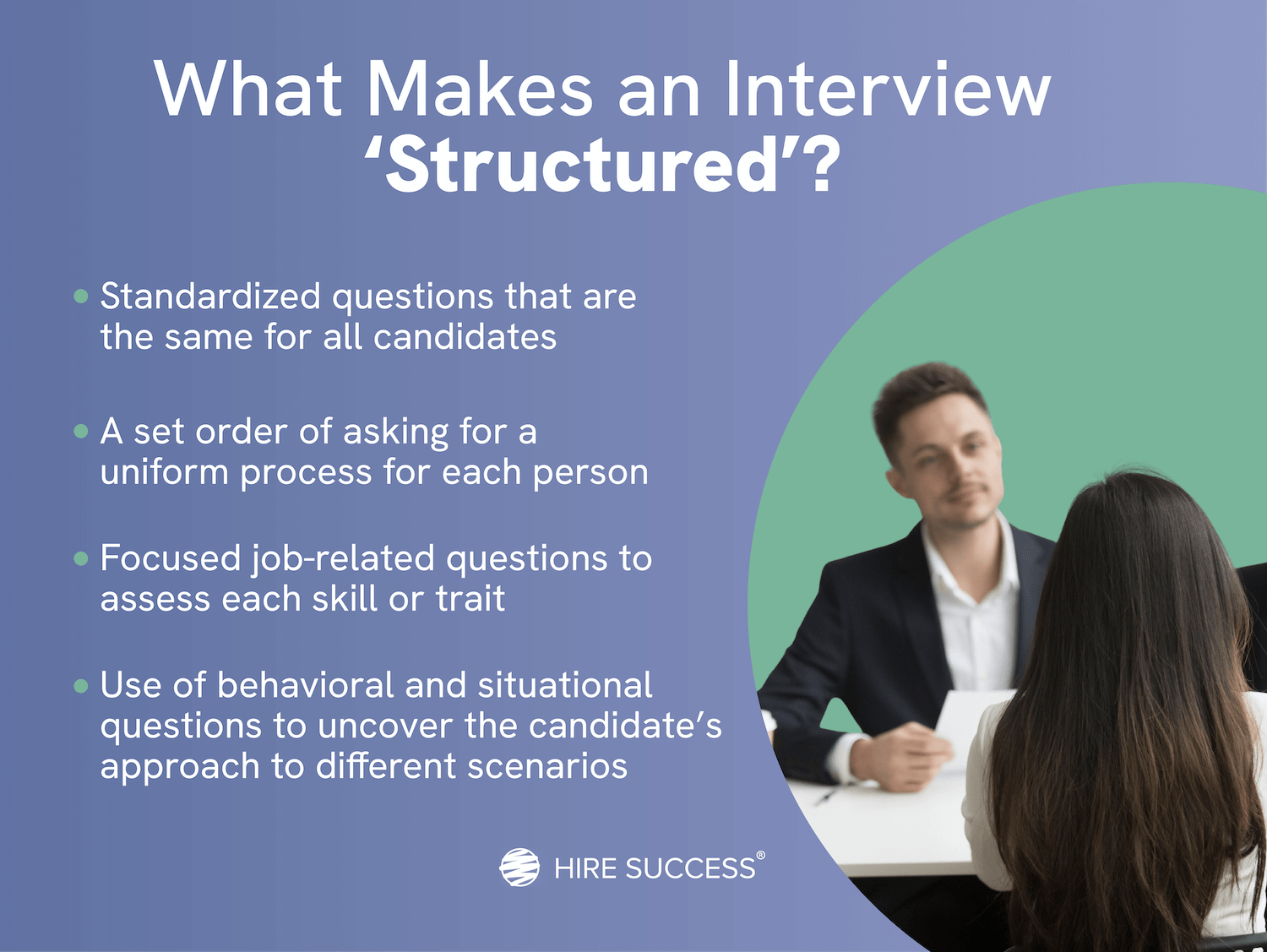
A structured interview standardizes the questions asked of each potential employee. You consistently use the same set of predetermined questions, asked in the same order. You then evaluate the responses against clear, established criteria for fairness. Typical features of a structured interview include:
- Standardized questions that are the same for all candidates
- A set order of asking for a uniform process for each person
- Evaluation criteria established in advance for an objectively fair process
- Focused job-related questions to assess each skill or trait
- Use of behavioral and situational questions to uncover the candidate's approach to different scenarios
Benefits of a structured approach
A structured interview gives clear benefits by making the hiring process consistent, efficient, and objectively fair. For example, by taking a structured approach, you can:
- Reduce bias. Sticking with the same questionnaire for everyone puts all candidates on a level playing field. You can focus on their answers and qualifications without relying on a gut feeling or general personal impression.
- Simplify candidate comparisons. With everyone answering the same questions, you can compare each candidate's answers and see who stands out.
- Improve preparation. You are less likely to miss a key topic or skill area when using predetermined questions.
- Save time. Structured interviews tend to move along quickly and stay on track, making the best use of time.
Example structured interview questions
To give you an idea of what a structured interview question looks like, here are some of the most commonly asked ones:
- Can you describe how you solved a challenging problem at work?
- When juggling competing demands and multiple deadlines, how do you prioritize tasks?
- Tell me about your most recent experience working on a team. What was your role, and what did you achieve?
- What about this position interests you, and how does your background and ability fit with our needs?
What is an unstructured interview?

An unstructured interview is an open conversation that takes a flexible approach, flowing naturally to explore a candidate's background and abilities. You can ask follow-up questions to probe areas of particular interest or if you uncover confusing or conflicting information.
Unstructured interview questions are ideal for capturing rich answers that address complex issues. You can adjust the conversation based on what each candidate says without being handcuffed by a set list of questions. Typical features of a structured interview include:
- No scripted list of questions
- Open-ended prompts to give candidates wide latitude in answering
- Naturally flowing conversation that progresses based on a candidate's answers and your interests
- Deep and detailed answers that give you a thorough and nuanced understanding of the candidate
- Flexibility in adjusting the direction of the interview to explore topics and issues as they arise
Sample questions for unstructured interviews
In preparing your interview guide, it can be helpful to see what open-ended, conversational questions look like. Here are some examples:
- Tell me about yourself.
- What have you recently learned that was exciting to you and why?
- What do you need to thrive in a given work environment?
- If you could create the ideal role for yourself, how would you describe it?
Benefits of the unstructured method
Unstructured interviews feel natural and can put candidates at ease. They also give you freedom in learning about topics that matter. Here are the key advantages of this interview style:
- Provides richer insights. Because you are not limited to a script, you can take a deep dive into a candidate's experiences, ideas, and personality for details that a structured questionnaire may miss.
- Offers greater flexibility. Unstructured interviews give you the freedom to explore interesting topics that a candidate's answers open.
- Allows for more natural conversation. If the interviewer has good intuition and can formulate questions on the spot, they can get a better sense of the candidate's skills and fit.
Move beyond resumes, identify true potential
Make smarter hiring decisions using objective data on candidates' strengths, work styles, and personality traits.
Book a Demo Try It FreeWhen should you use the structured approach in hiring?
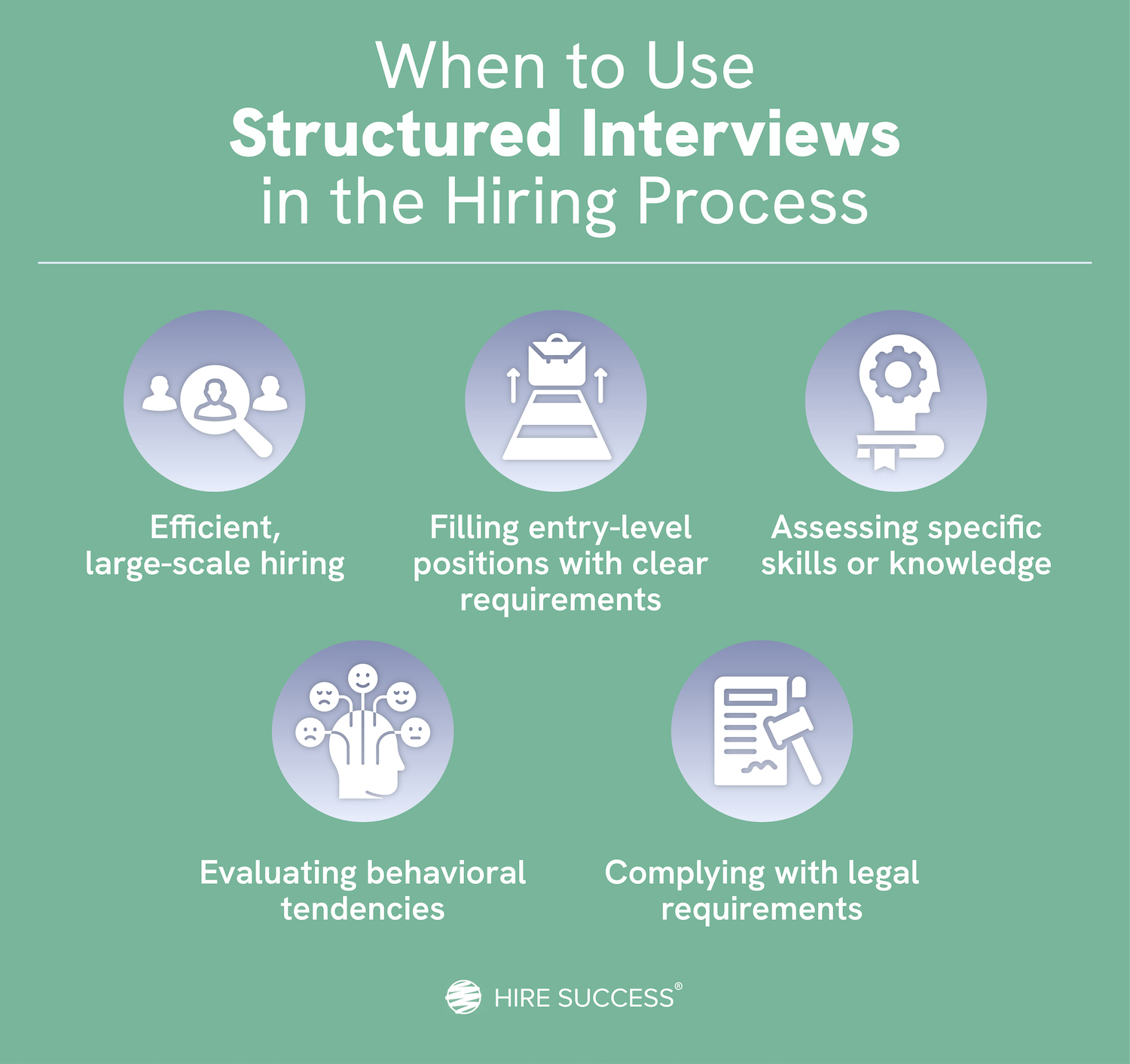
A structured interview approach is often used by large organizations to reduce bias and improve efficiency. The U.S. Office of Personnel Management (OPM) recommends that government agencies take a structured approach to ensure fairness and consistency. Google's guide to structured interviews emphasizes that it makes for more reliable hiring decisions.
What will work best for you depends on your situation. Here are several scenarios where a structured interview offers clear advantages:
- Efficient, large-scale hiring: When bringing on many people to staff similar roles, the consistency and efficiency of structured interviews enable a fair and faster evaluation.
- Filling entry-level positions with clear requirements: When a job requires specific and well-defined skills, a structured interview helps you find qualified candidates quickly.
- Assessing specific skills or knowledge: Determining if someone can perform a task or has the needed subject matter expertise is relatively easy with a standardized set of questions.
- Evaluating behavioral tendencies: Using a framework like the STAR method (Situation, Task, Action, Result) can help you understand candidate behaviors and how they might respond to a real-life challenge.
- Complying with legal requirements: Some industries and government settings require that you document equal treatment and prove your hiring process is fair and non-discriminatory.
Structured interviews have some disadvantages that limit their suitability in some situations. For example, you may:
- Need more time to plan. You need to invest in preparation when creating a structured interview questionnaire.
- Miss opportunities to go in-depth. If you are forced to stay on script, you cannot easily ask more in-depth questions on any areas of interest.
- Present your organization in a rigid or cold manner. These interviews can feel impersonal and even come across as an interrogation. The formality makes it harder to gauge personality.
When to use unstructured interviews
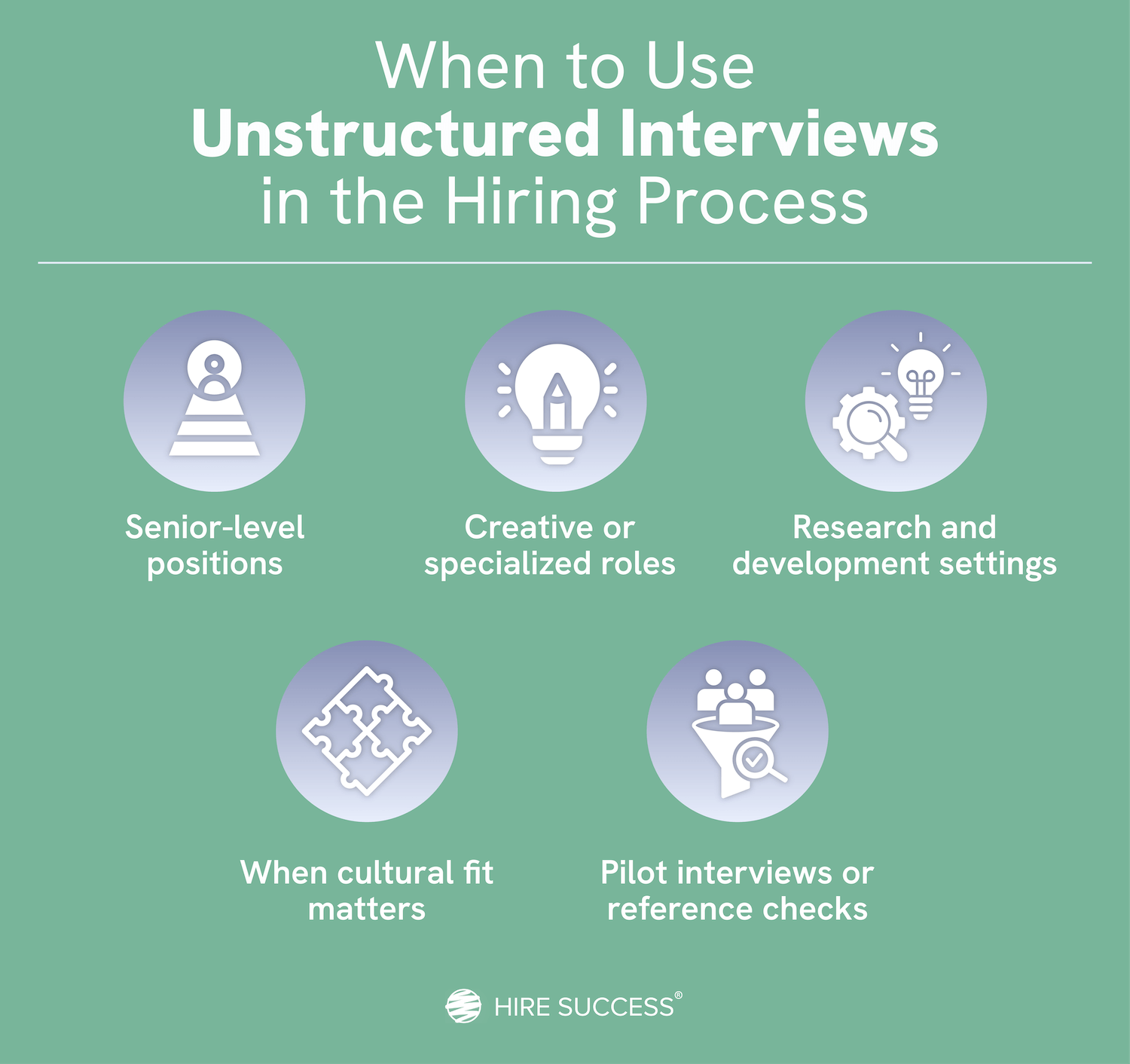
The conversational approach of an unstructured interview and its ability to quickly adapt to the direction of the conversation are clear advantages. This is especially true for roles requiring in-depth discussions of experience and skills, or assessing candidates' potential and fit with the company culture. It is ideal for finding talent for creative roles, positions that require interpersonal finesse, and to find strategic thinkers.
Here are some examples of when an unstructured interview might be useful:
- Senior-level positions: Hiring for leadership roles requires learning about personality management style, problem solving, and strategic thinking as much as specific technical skills. You need a deep and nuanced conversation to explore these areas.
- Creative or specialized roles: When the position calls for intuition, adaptability, originality, and inventiveness, the flexible interview style lets the candidate truly shine.
- Research and development settings: In environments that demand new ideas and approaches, an open-ended conversation gives you insight into how a candidate might take on a problem or come up with an innovation.
- When cultural fit matters: Finding the right person to fit into the team dynamic and the ways your company operates is best done with an informal interview that delves into personality, values, and communication styles.
- Pilot interviews or reference checks: For a preliminary screening, a trial version to inform a structured interview questionnaire, or for conversations with references, an unstructured approach allows for follow-up questions and discovering valuable insights.
Some of the challenges around unstructured interviews should be kept in mind, such as:
- Getting distracted during the interview. Without having questions prepared in advance, you may forget something or miss learning about a critical trait or skill. It also requires exceptional active listening skills.
- Misjudging the interviewee. Because your questions may vary greatly from one candidate to another, it's much harder to compare candidates and their answers. You can also easily develop a bias or make a snap judgment.
- Not asking the right questions. This approach requires a skilled interviewer who can hear a topic that needs a deep dive and formulate a good probing question on the spot. If you don't ask the right interview questions, you may not get the information you need to pick the right person.
Interview methods: A side-by-side comparison
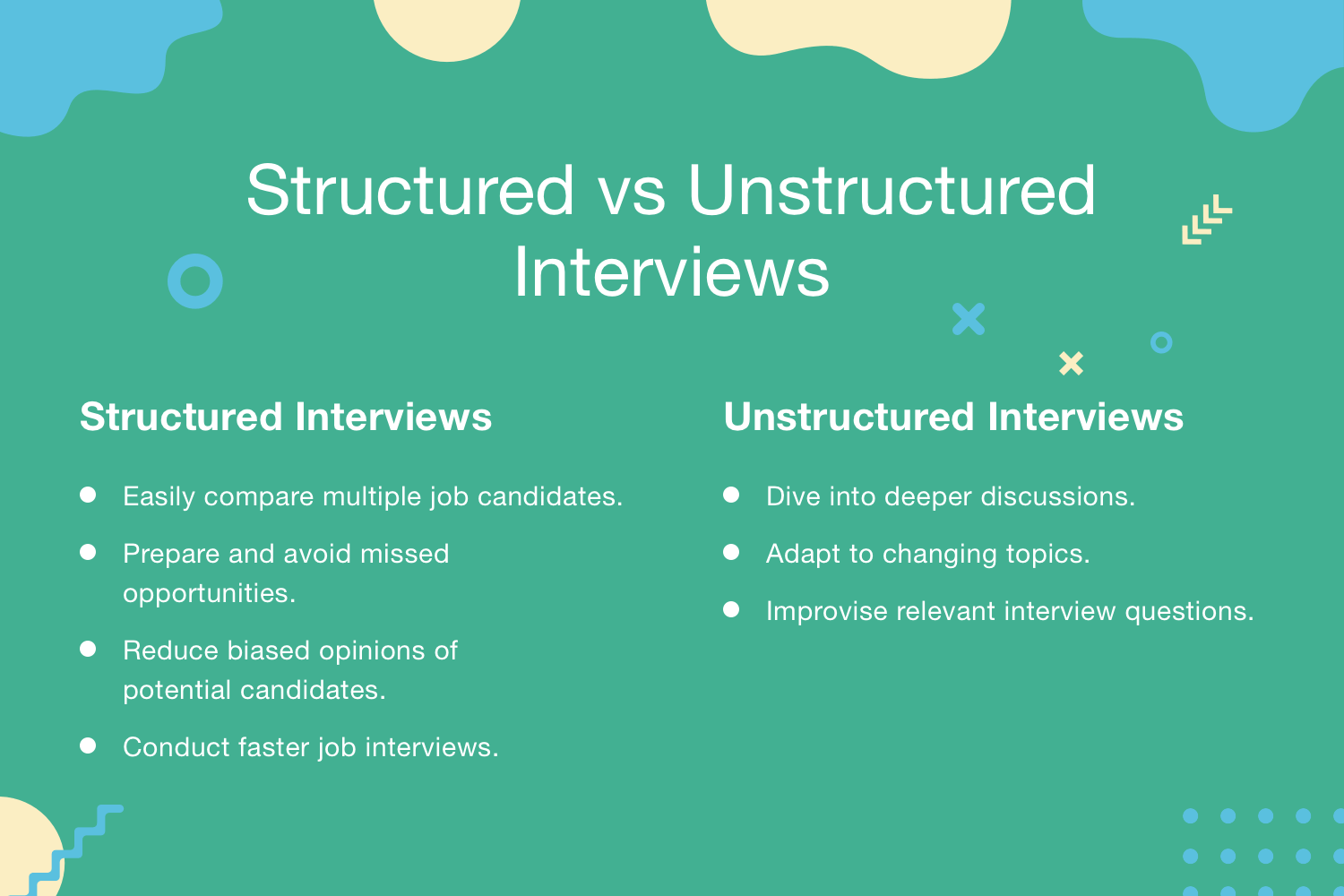
Both structured and unstructured interview styles have their advantages. Here is a compilation of the key differences to help you choose the right approach for your situation.
| Interview Type | Structured | Unstructured |
|---|---|---|
| Definition | A formal interview with a fixed list of questions to be asked in a specific order | A flexible, open-ended talk that flows according to the interviewer's interests and judgment |
| Question format | Standardized for all candidates | Spontaneous and varied based on the candidate |
| Flexibility | Not flexible | Highly dynamic |
| Consistency | The same for all candidates | Inconsistent, with every candidate having a different experience |
| Bias reduction | Minimizes bias | Greater risk for bias and discrimination |
| Preparation time | Time-consuming prep is needed | Informality means you can wing it and talk “off the cuff” |
| Predictive validity | Proven to predict job performance | Less reliable in forecasting success |
| Evaluation | Easy and more efficient | Time-consuming and more subjective |
| Candidate experience | Can feel impersonal | Feels relaxed and natural |
| Best suited for | Hiring large numbers, entry-level positions, and roles in regulated fields | Ideal for leadership, strategic, creative, and specialized roles, and in situations where cultural fit matters |
Structured vs. unstructured interviews: Which should you choose?
Making the right choice between structured vs. unstructured interview styles depends on several factors:
- What is the role you are hiring for?
- What is the level of seniority?
- How many people will you need?
- What information will you be using to make a hiring decision?
The answers to these and other questions will drive your choice.
Structured interviews take expertise and time to set up, but they will help with faster, more efficient, and less biased decision making. Numerous studies have found that structured interviews are superior in providing better hiring results.
Unstructured interviews, with their flexible and conversational approach, also have their strengths and are useful in certain situations.
Why don't more organizations use the structured interview method?
Structured interviewing has proven effective in predicting on-the-job performance, reducing bias, and making the hiring process more efficient. However, many organizations continue to take an unstructured approach. People prefer the familiar, and managers often like to “go with their gut.”
The biggest myth around structured interviews is that they are too rigid and limiting. Possibly the biggest impediment is that it takes time and expertise to craft a structured interview script, both of which are scarce. You need training to use it well and discipline to stick to it.
As Google's hiring guide states, a structured approach is worth the effort in the quality of hire, fairness, and efficiency it provides.
Best of both: Semi-structured interviews
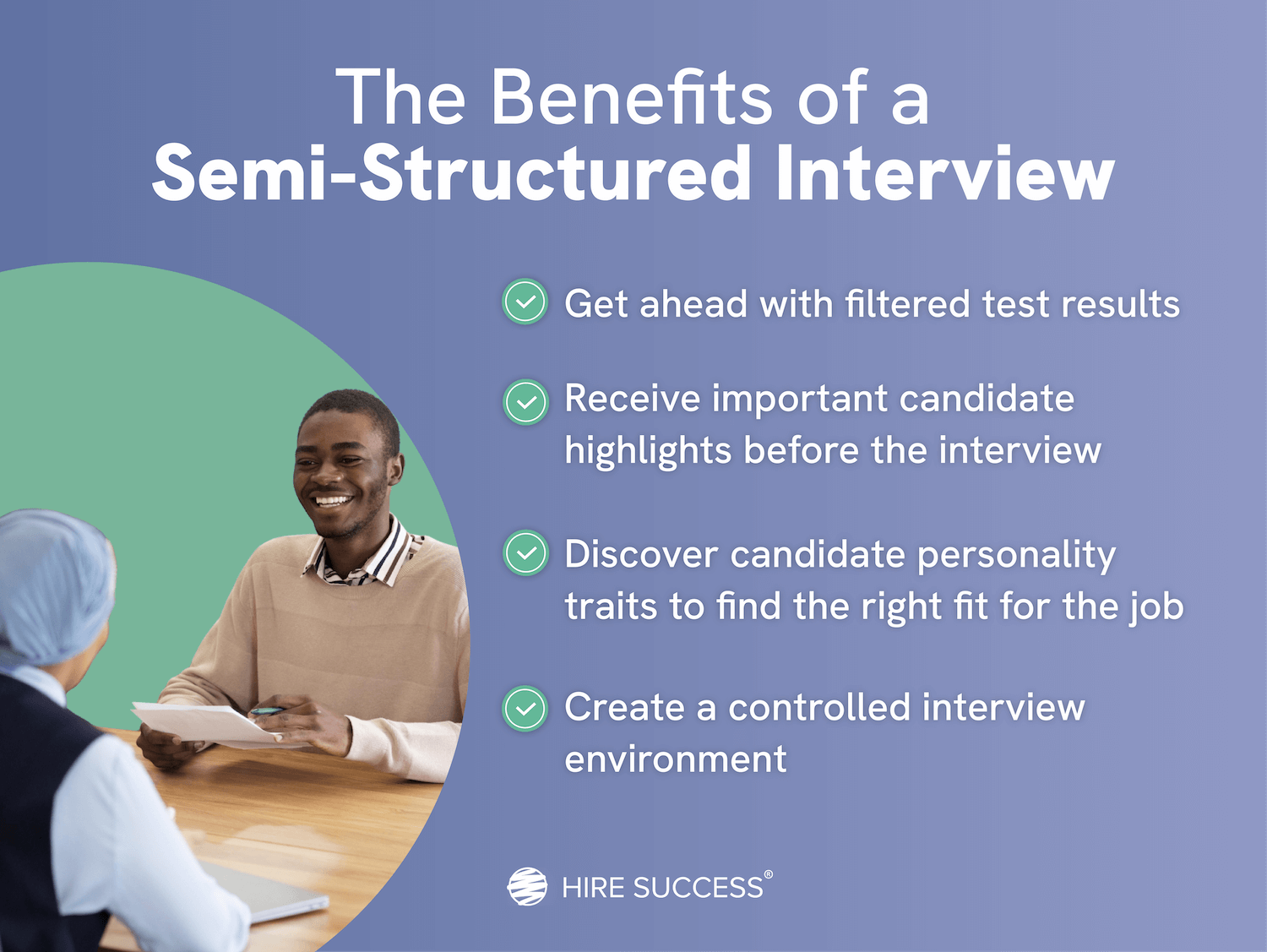
A semi-structured interview is a way to get the benefits of both approaches. Creating a semi-structured guide gives you the structure needed for efficiency and fairness, but offers some flexibility with open-ended questions and follow-ups that let the interviewer dive deeper into a topic to understand the nuances of the interviewee's experience, style, and personality, or to uncover vital information about an unexpected topic.
While AI can be helpful in constructing a semi-structured guide, you're better off using specialized software like that offered by Hire Success® to ensure compliance with the legalities of pre-employment testing and to choose questions that are scientifically based to get the information you want.
Hire Success® helps you reap all the benefits of both structured and unstructured interview models to create a kind of “superstructured” interview. Here's how:
- Get ahead with filtered test results. By administering preliminary skills, integrity, and personality testing to all pre-qualified candidates, you obtain answers to important structured interview questions before you interview. You'll save a lot of valuable time by cutting out candidates who don't meet your baseline needs prior to the interview process.
- Receive important candidate highlights before the interview. Having testing results speeds up the process of planning a structured interview because Hire Success® highlights important points for you in its reports. You also won't forget to ask key questions, because our Interviewer's Guide plots out queries.
- Discover candidate personality traits to find the right fit for the job. With results from a personality profile test, you'll already have insight about personality traits that you've identified as being critical for the job. You can concentrate your time on areas of concern, making each interview more personal.
- Create a controlled interview environment. Test results help you remain unbiased because they focus on data. In fact, your data-based test results are more likely to help you identify candidates who might otherwise have been missed.
It's best to keep in mind your business's needs and objectives when deciding which type of style is best for your interviewing process. Choosing the Hire Success® interviewing system can help you combine the advantages of structured vs. unstructured interviews.
Want to know more about our hiring system? Get a personalized walk-through of our interviewing solutions.


